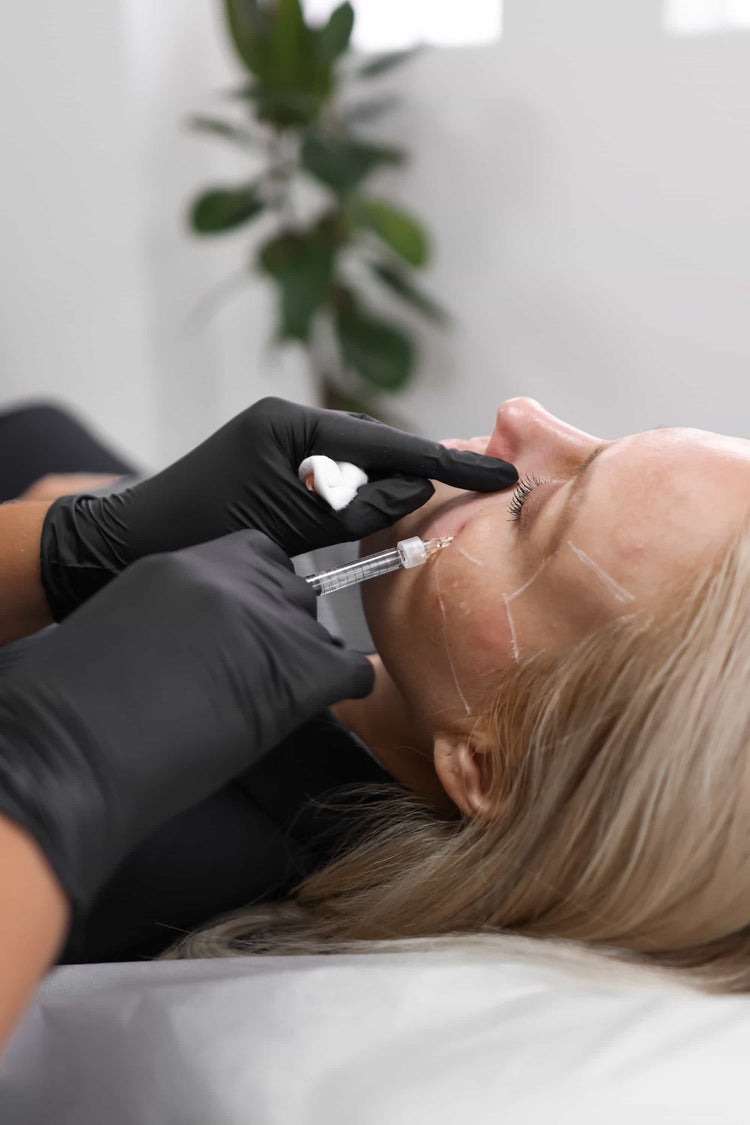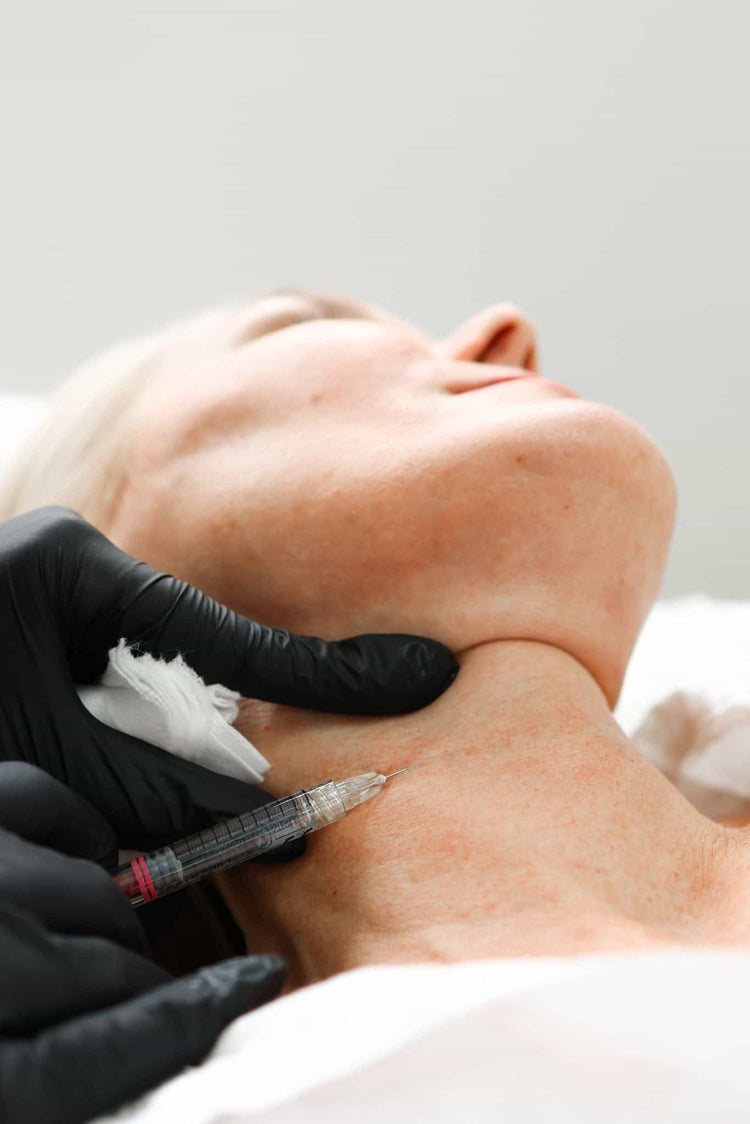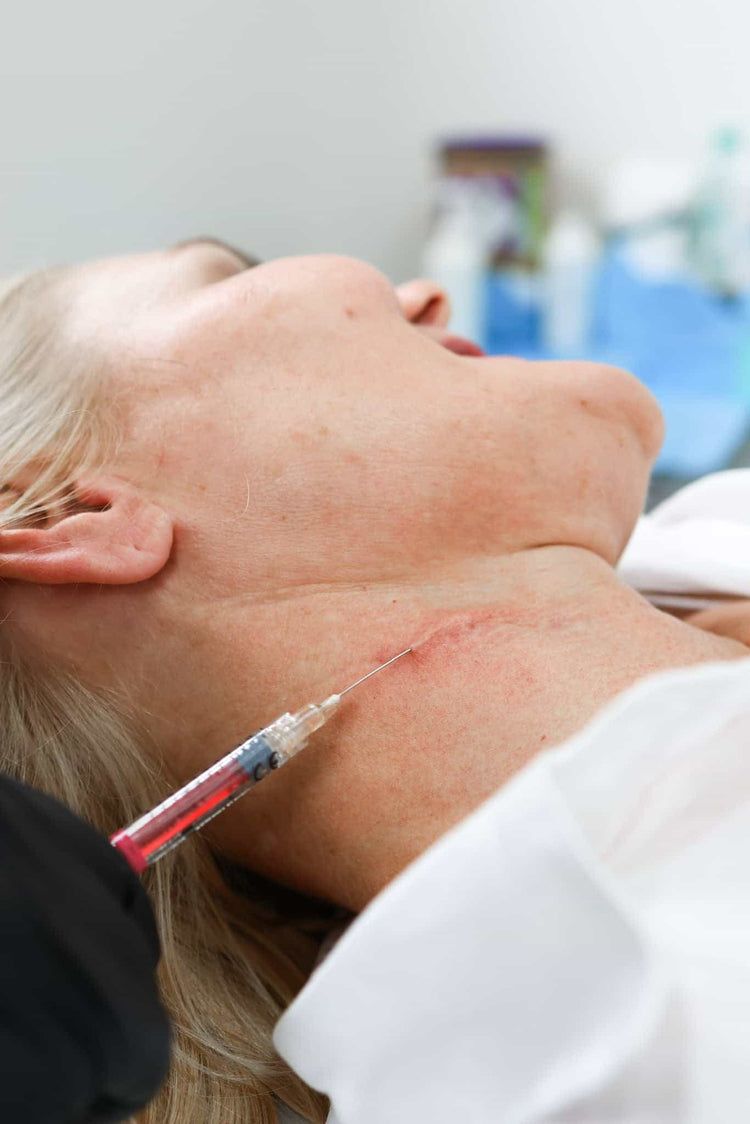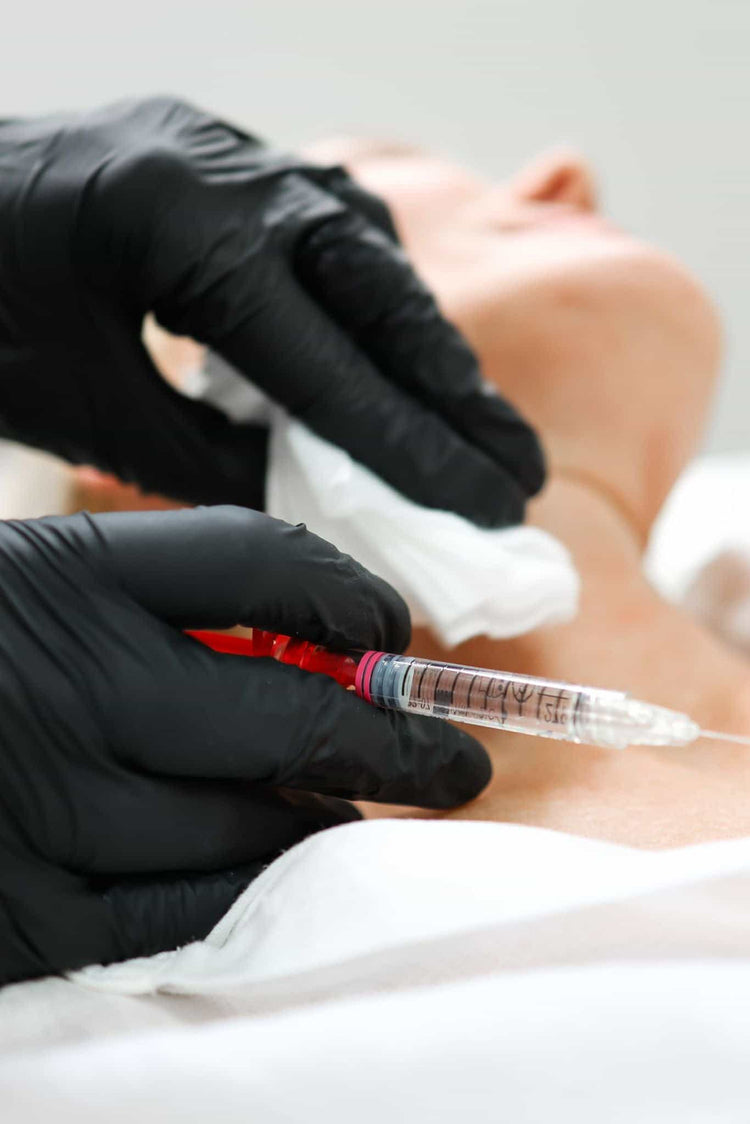Types of Facial Fillers
Non-surgical facial fillers have become increasingly popular in recent years as a safe and effective way to address signs of aging and enhance facial features. These injectables utilize various gel-like substances, each with unique properties and applications. From smoothing wrinkles and restoring volume loss to shaping lips and defining cheekbones, facial fillers offer a versatile approach to achieving a more youthful and refreshed appearance.
Hyaluronic Acid

Hyaluronic acid is the most common type of facial filler. It’s a naturally occurring substance in the body that helps to hydrate and plump skin. When injected, hyaluronic acid attracts water, adding volume to areas where it’s been applied. This makes it effective for smoothing wrinkles, reducing fine lines, and restoring fullness to cheeks, lips, and other facial features.
Other types of fillers include poly-L-lactic acid (PLLA), calcium hydroxylapatite (CaHA), and silicone. PLLA stimulates collagen production, which can improve skin elasticity and firmness over time. CaHA is a mineral-based filler that provides immediate volume and can last for several months. Silicone is a synthetic material that is long-lasting but may carry a higher risk of complications.
Poly-L-Lactic Acid (PLLA)
Poly-L-lactic acid (PLLA) is a biodegradable and biocompatible filler that stimulates the body’s natural collagen production. Unlike hyaluronic acid fillers which provide immediate volume, PLLA works gradually over several weeks or months as it triggers collagen synthesis. This gradual process results in a more long-lasting effect, with improvements in skin texture, elasticity, and firmness.

Calcium Hydroxyapatite
Calcium hydroxylapatite (CaHA) is a mineral-based filler derived from naturally occurring calcium phosphate crystals found in bones and teeth. When injected into the skin, CaHA particles stimulate collagen production, helping to restore volume and improve skin texture.
CaHA fillers are known for their immediate volumizing effect and longevity, typically lasting 6 to 18 months depending on individual factors such as treatment area and lifestyle.

They are also considered to be a safe and biocompatible option, with a low risk of allergic reactions or long-term complications. CaHA fillers are commonly used to address wrinkles, folds, and creases, as well as to enhance cheekbones and jawline definition.
Benefits of Non-Surgical Facial Fillers
Non-surgical facial fillers offer a popular and effective way to address signs of aging in Caterham, Surrey. These injectables utilize gel-like substances that can smooth wrinkles, restore volume loss, shape lips, and define features. From hyaluronic acid’s natural hydrating properties to the collagen-stimulating effects of PLLA, there are various types of fillers tailored to individual needs and desired outcomes.
Reducing Wrinkles and Fine Lines
Non-surgical facial fillers have become increasingly popular in recent years as a safe and effective way to address signs of aging and enhance facial features. These injectables utilize various gel-like substances, each with unique properties and applications. From smoothing wrinkles and restoring volume loss to shaping lips and defining cheekbones, facial fillers offer a versatile approach to achieving a more youthful and refreshed appearance.
Hyaluronic acid is the most common type of facial filler. It’s a naturally occurring substance in the body that helps to hydrate and plump skin. When injected, hyaluronic acid attracts water, adding volume to areas where it’s been applied. This makes it effective for smoothing wrinkles, reducing fine lines, and restoring fullness to cheeks, lips, and other facial features.

- PLLA (Poly-L-lactic acid) stimulates collagen production, improving skin elasticity and firmness over time.
- CaHA (Calcium hydroxylapatite) is a mineral-based filler that provides immediate volume and can last for several months.
- Silicone is a synthetic material that is long-lasting but may carry a higher risk of complications.
Facial Contouring
Non-surgical facial fillers have become increasingly popular in recent years as a safe and effective way to address signs of aging and enhance facial features. These injectables utilize various gel-like substances, each with unique properties and applications. From smoothing wrinkles and restoring volume loss to shaping lips and defining cheekbones, facial fillers offer a versatile approach to achieving a more youthful and refreshed appearance.
Hyaluronic acid is the most common type of facial filler. It’s a naturally occurring substance in the body that helps to hydrate and plump skin. When injected, hyaluronic acid attracts water, adding volume to areas where it’s been applied. This makes it effective for smoothing wrinkles, reducing fine lines, and restoring fullness to cheeks, lips, and other facial features.
Other types of fillers include poly-L-lactic acid (PLLA), calcium hydroxylapatite (CaHA), and silicone. PLLA stimulates collagen production, which can improve skin elasticity and firmness over time. CaHA is a mineral-based filler that provides immediate volume and can last for several months. Silicone is a synthetic material that is long-lasting but may carry a higher risk of complications.
Poly-L-lactic acid (PLLA) is a biodegradable and biocompatible filler that stimulates the body’s natural collagen production. Unlike hyaluronic acid fillers which provide immediate volume, PLLA works gradually over several weeks or months as it triggers collagen synthesis. This gradual process results in a more long-lasting effect, with improvements in skin texture, elasticity, and firmness.
Calcium hydroxylapatite (CaHA) is a mineral-based filler derived from naturally occurring calcium phosphate crystals found in bones and teeth. When injected into the skin, CaHA particles stimulate collagen production, helping to restore volume and improve skin texture.
CaHA fillers are known for their immediate volumizing effect and longevity, typically lasting 6 to 18 months depending on individual factors such as treatment area and lifestyle.
They are also considered to be a safe and biocompatible option, with a low risk of allergic reactions or long-term complications. CaHA fillers are commonly used to address wrinkles, folds, and creases, as well as to enhance cheekbones and jawline definition.
Non-surgical facial fillers offer a popular and effective way to address signs of aging in Caterham, Surrey. These injectables utilize gel-like substances that can smooth wrinkles, restore volume loss, shape lips, and define features. From hyaluronic acid’s natural hydrating properties to the collagen-stimulating effects of PLLA, there are various types of fillers tailored to individual needs and desired outcomes.
Non-surgical facial fillers have become increasingly popular in recent years as a safe and effective way to address signs of aging and enhance facial features. These injectables utilize various gel-like substances, each with unique properties and applications. From smoothing wrinkles and restoring volume loss to shaping lips and defining cheekbones, facial fillers offer a versatile approach to achieving a more youthful and refreshed appearance.
Hyaluronic acid is the most common type of facial filler. It’s a naturally occurring substance in the body that helps to hydrate and plump skin. When injected, hyaluronic acid attracts water, adding volume to areas where it’s been applied. This makes it effective for smoothing wrinkles, reducing fine lines, and restoring fullness to cheeks, lips, and other facial features.
Enhancing Lip Shape and Volume
Non-surgical facial fillers offer a versatile solution for enhancing lip shape and volume. These injectables use gel-like substances that add fullness and definition to the lips, creating a more youthful and attractive appearance. Hyaluronic acid is a popular choice for lip augmentation as it attracts water and plumps the skin naturally.
By strategically injecting hyaluronic acid into different areas of the lips, practitioners can customize the results. It’s possible to enhance the fullness of the entire lip, define the cupid’s bow, or create a more symmetrical shape.
The results of lip filler treatments are typically visible immediately and can last for several months depending on the type of filler used and individual factors.
Restoring lost Volume in the Cheeks
Non-surgical facial fillers provide a popular and effective solution for restoring lost volume in the cheeks, addressing one of the most common signs of aging. As we age, our natural collagen and fat deposits decline, leading to a loss of fullness in the cheeks and a more sunken appearance.
Facial fillers, such as hyaluronic acid-based injectables, can effectively replenish this lost volume, restoring a more youthful and defined contour to the cheeks. These fillers are injected into the cheek area, gradually lifting and plumping the skin for a natural-looking enhancement.
The results of cheek filler treatments are typically immediate and can last anywhere from 6 months to 2 years, depending on the individual and the type of filler used.
Procedure and Aftercare
Understanding the procedure and aftercare involved in non-surgical facial fillers is essential for maximizing your results and ensuring a safe and comfortable experience.
Consultation and Treatment Planning
Consultation and Treatment Planning
- Initial Consultation: Before undergoing any treatment, it’s crucial to have a thorough consultation with a qualified practitioner. This allows for a comprehensive assessment of your facial features, skin type, concerns, and desired outcomes.
- Treatment Plan Discussion: The practitioner will discuss your goals and explain the different types of fillers available, their suitability for your needs, and the potential results you can expect.
- Realistic Expectations Setting: It’s important to have realistic expectations about what facial fillers can achieve. A skilled practitioner will help you understand the limitations of the treatment and guide you towards achievable goals.
Procedure
- Preparation: The treatment area will be cleansed and sterilized.
- Numbing Cream: A topical anesthetic may be applied to minimize any discomfort during the injection process.
- Injection Technique: The practitioner will carefully inject the chosen filler into specific points within the target areas using fine needles or cannulas.
- Duration: The entire procedure usually takes 30 minutes to an hour, depending on the areas being treated and the amount of filler used.
Aftercare
- Ice Packs: Applying ice packs to the treatment area for 15-20 minutes at a time can help reduce any swelling or bruising.
- Avoid Touching: Refrain from touching, rubbing, or massaging the treated areas for at least 24 hours to avoid displacing the filler.
- Limit Sun Exposure: Protect your skin from excessive sun exposure by wearing sunscreen with an SPF of 30 or higher.
- Hydration: Stay well-hydrated by drinking plenty of water to help maintain skin elasticity and support the effects of the filler.
- Follow Practitioner’s Instructions: Adhere to any specific aftercare instructions provided by your practitioner for optimal healing and results.
- Initial Consultation: Before undergoing any treatment, it’s crucial to have a thorough consultation with a qualified practitioner. This allows for a comprehensive assessment of your facial features, skin type, concerns, and desired outcomes.
- Treatment Plan Discussion: The practitioner will discuss your goals and explain the different types of fillers available, their suitability for your needs, and the potential results you can expect.
- Realistic Expectations Setting: It’s important to have realistic expectations about what facial fillers can achieve. A skilled practitioner will help you understand the limitations of the treatment and guide you towards achievable goals.
- Preparation: The treatment area will be cleansed and sterilized.
- Numbing Cream: A topical anesthetic may be applied to minimize any discomfort during the injection process.
- Injection Technique: The practitioner will carefully inject the chosen filler into specific points within the target areas using fine needles or cannulas.
- Duration: The entire procedure usually takes 30 minutes to an hour, depending on the areas being treated and the amount of filler used.
- Ice Packs: Applying ice packs to the treatment area for 15-20 minutes at a time can help reduce any swelling or bruising.
- Avoid Touching: Refrain from touching, rubbing, or massaging the treated areas for at least 24 hours to avoid displacing the filler.
- Limit Sun Exposure: Protect your skin from excessive sun exposure by wearing sunscreen with an SPF of 30 or higher.
- Hydration: Stay well-hydrated by drinking plenty of water to help maintain skin elasticity and support the effects of the filler.
- Follow Practitioner’s Instructions: Adhere to any specific aftercare instructions provided by your practitioner for optimal healing and results.
- Initial Consultation: Before undergoing any treatment, it’s crucial to have a thorough consultation with a qualified practitioner. This allows for a comprehensive assessment of your facial features, skin type, concerns, and desired outcomes.
- Treatment Plan Discussion: The practitioner will discuss your goals and explain the different types of fillers available, their suitability for your needs, and the potential results you can expect.
- Realistic Expectations Setting: It’s important to have realistic expectations about what facial fillers can achieve. A skilled practitioner will help you understand the limitations of the treatment and guide you towards achievable goals.
- Preparation: The treatment area will be cleansed and sterilized.
- Numbing Cream: A topical anesthetic may be applied to minimize any discomfort during the injection process.
- Injection Technique: The practitioner will carefully inject the chosen filler into specific points within the target areas using fine needles or cannulas.
- Duration: The entire procedure usually takes 30 minutes to an hour, depending on the areas being treated and the amount of filler used.
- Ice Packs: Applying ice packs to the treatment area for 15-20 minutes at a time can help reduce any swelling or bruising.
- Avoid Touching: Refrain from touching, rubbing, or massaging the treated areas for at least 24 hours to avoid displacing the filler.
- Limit Sun Exposure: Protect your skin from excessive sun exposure by wearing sunscreen with an SPF of 30 or higher.
- Hydration: Stay well-hydrated by drinking plenty of water to help maintain skin elasticity and support the effects of the filler.
- Follow Practitioner’s Instructions: Adhere to any specific aftercare instructions provided by your practitioner for optimal healing and results.
Administration of the Filler
Understanding the procedure and aftercare involved in non-surgical facial fillers is essential for maximizing your results and ensuring a safe and comfortable experience.
Consultation and Treatment Planning
Procedure
Aftercare
Recovery and Downtime
Understanding the procedure and aftercare involved in non-surgical facial fillers is essential for maximizing your results and ensuring a safe and comfortable experience.
Consultation and Treatment Planning
Procedure
Aftercare
Recovery from non-surgical facial fillers is typically quick. Most patients can resume their normal activities immediately following the procedure. Some mild swelling, bruising, or redness may occur at the injection sites, but these side effects usually subside within a few days to a week.
Downtime is minimal. You should avoid strenuous activity and excessive sun exposure for at least 24 hours after treatment. It’s also important to follow your practitioner’s specific aftercare instructions carefully to minimize any potential risks or complications.
Potential Side Effects and Risks
Non-surgical facial fillers offer a popular way to rejuvenate the face, but it’s essential to be aware of potential side effects and risks before undergoing the procedure.
**Potential Side Effects:**
* **Swelling:** This is the most common side effect, typically mild and resolving within a few days.
* **Bruising:** Some bruising may occur at the injection sites, usually lasting a week or less.
* **Redness and tenderness:** The treated area may be slightly red and tender for a day or two.
* **Lumps or bumps:** These are temporary and often resolve on their own within a few weeks.
**Serious Risks (Rare):**
While generally safe, facial fillers do carry some risks, though they are relatively uncommon:
* **Infection:** Any injection carries a risk of infection, which can be minimized with proper hygiene practices by the practitioner.
* **Allergic reaction:** Although rare, an allergic reaction to the filler material can occur.
* **Vascular occlusion:** In extremely rare cases, filler injection can block blood vessels, leading to tissue damage. This is why it’s crucial to choose a qualified and experienced practitioner who understands proper injection techniques.
**Factors Affecting Risks:**
* **Type of filler used:** Some fillers carry a higher risk profile than others.
* **Individual medical history:** Certain medical conditions or medications can increase the risk of complications.
* **Practitioner’s skill and experience:** A qualified and experienced practitioner will minimize risks through proper training, techniques, and patient selection.
It is vital to consult with a board-certified dermatologist or plastic surgeon to discuss your individual needs and concerns. They will evaluate your medical history, skin type, and desired outcomes to determine if non-surgical facial fillers are appropriate for you and to explain potential side effects and risks in more detail.
Finding a Qualified Practitioner
Finding a qualified practitioner is essential for a safe and successful experience with non-surgical facial fillers. Look for practitioners who are board-certified dermatologists or plastic surgeons with specialized training and experience in injectables.
Qualifications and Experience
Finding a qualified practitioner is crucial when considering non-surgical facial fillers.
Here’s what to look for:
* **Board Certification:** Ensure the practitioner is board-certified by a reputable organization, such as the American Board of Dermatology or the American Board of Plastic Surgery. This signifies they have met rigorous training and education standards.
* **Experience with Fillers:** Inquire about the practitioner’s experience specifically with facial fillers. Ask how many procedures they perform annually and what types of fillers they are proficient in using.
* **Before-and-After Photos:** Request to see before-and-after photos of patients who have undergone similar treatments. This can provide insight into the practitioner’s aesthetic sense and skill level.
* **Consultation Process:** A comprehensive consultation is essential. The practitioner should listen attentively to your concerns, understand your desired outcomes, and thoroughly assess your facial anatomy and skin type. They should also explain the procedure in detail, including potential risks and benefits, and address any questions you may have.
* **Office Environment:** Visit the practitioner’s office to evaluate its cleanliness, professionalism, and overall ambiance.
Remember, non-surgical facial fillers are a medical procedure, and your safety and well-being should be paramount. Choosing a qualified and experienced practitioner significantly increases your chances of achieving satisfying results and minimizing potential complications.
Patient Reviews and Testimonials
Finding a qualified practitioner is crucial when considering non-surgical facial fillers. Look for board-certified dermatologists or plastic surgeons with specialized training and experience in injectables.
Here’s how to find the right practitioner for you:
* **Ask for Referrals:** Talk to your primary care physician, friends, or family who have had positive experiences with facial fillers.
* **Check Online Reviews:** Websites like RealSelf and Healthgrades allow patients to share their experiences with practitioners. Pay attention to both positive and negative reviews, and look for patterns in the feedback.
* **Contact Professional Organizations:** The American Society of Plastic Surgeons (ASPS) and the American Academy of Dermatology (AAD) have online directories of certified professionals. You can search by location to find qualified practitioners in your area.
Once you have a few potential candidates, schedule consultations with each one. During the consultation, ask about their experience with facial fillers, their training, and their approach to patient care. Be sure to discuss your individual goals and concerns openly and honestly.
Remember, choosing a skilled and experienced practitioner is essential for achieving safe and effective results with non-surgical facial fillers.
Consultation Process and Expectations
Finding a qualified practitioner is crucial when considering non-surgical facial fillers. Look for board-certified dermatologists or plastic surgeons with specialized training and experience in injectables. Here’s how to find the right practitioner for you:
* **Ask for Referrals:** Talk to your primary care physician, friends, or family who have had positive experiences with facial fillers.
* **Check Online Reviews:** Websites like RealSelf and Healthgrades allow patients to share their experiences with practitioners. Pay attention to both positive and negative reviews, and look for patterns in the feedback.
* **Contact Professional Organizations:** The American Society of Plastic Surgeons (ASPS) and the American Academy of Dermatology (AAD) have online directories of certified professionals. You can search by location to find qualified practitioners in your area.
Once you have a few potential candidates, schedule consultations with each one. During the consultation, inquire about their experience specifically with facial fillers, training, and approach to patient care. Discuss your individual goals and concerns openly and honestly. A good practitioner will take the time to understand your needs and provide personalized recommendations.
Book your first lip injection session with Dr. Laura Geige at It’s Me & You Clinic
- Why Does My Filler Only Last 3 Months? - November 14, 2025
- What Is The Danger Zone For Cheek Fillers? - November 11, 2025
- What Are The Best CBD Gummy Edibles For Focus And Productivity - November 9, 2025
